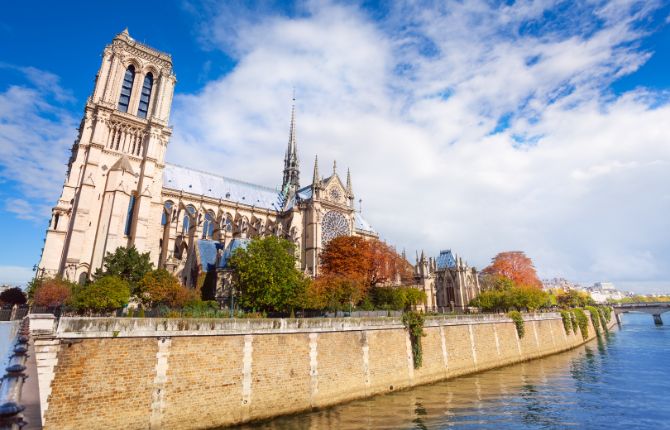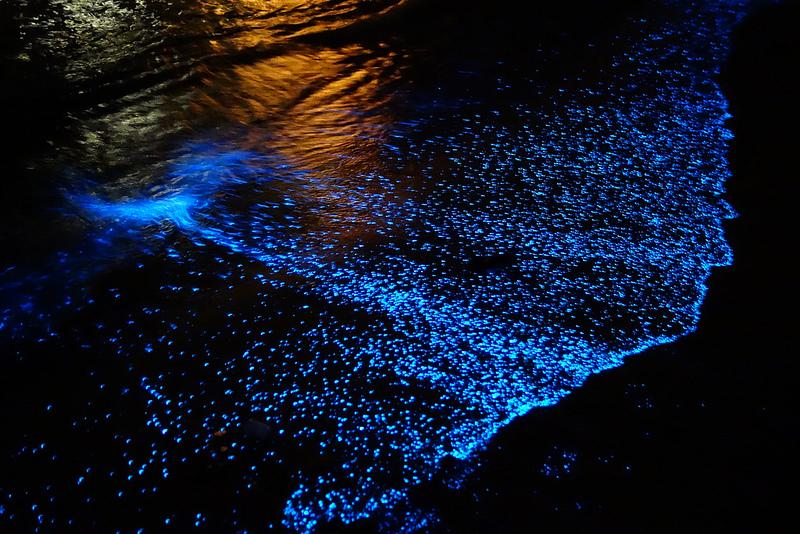Visiting the Cathédrale Notre-Dame de Paris is an experience like no other. The interior and exterior of the cathedral are both spectacular.
Visiting the top of the cathedral is a popular activity, with visitors enjoying the view. However, there is one drawback to climbing the stairs to the top: the number of people permitted is restricted and access can be difficult.
This can make it difficult for those with limited time to visit the cathedral.
To view the beautiful interior of the cathedral, you will need to climb the steep spiral staircase to reach the top of the tower. But, the climb is worth it, as you’ll be rewarded with breathtaking views of Paris.
The south tower also features a belfry and chimera gallery. The interior of the cathedral is also adorned with beautiful stained glass. You won’t regret visiting the Cathedrale Notre-Dame de Paris.
As you walk up the steps of the Notre Dame cathedral, remember to wear comfortable shoes. The revolving stairs could make you dizzy and nauseated. Be sure to wear comfortable shoes and clothing when you visit.
If you’re a photographer, you should bring a tripod to take beautiful photos of the interior.
Listed on UNESCO’s World Heritage List, Notre Dame is a must-see monument in Paris. But it’s important to avoid visiting the cathedral on the weekend when it is most crowded.
It may be best to visit during the week or early in the morning. The early bird has the best chance to visit this monument.
1. Cathédrale Notre-Dame de Paris: Gothic Architecture
The gothic architecture in Cathedrale Notre-Dame de Paris is a masterpiece of French medieval art.
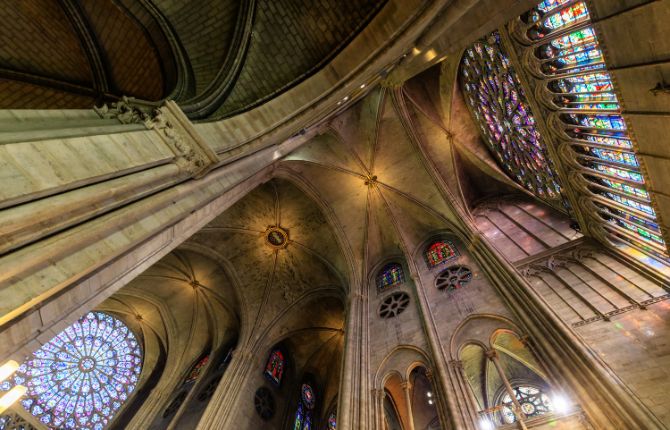
It’s the birthplace of modern French culture, and you can see the art firsthand in its stunning interior. Its medieval heart is a place where you can find Baudelaire, Rodin, and Matisse.
But it’s also a place where you can find more modern influences, like contemporary artwork by Matisse.
The original nave of Notre Dame was designed with clerestory windows. These windows filled the interior with light and helped the cathedral’s design achieve its current appearance.
They were made possible by improvements in structural support. Throughout the 13th century, the cathedral’s interior became more luminous, thanks to new windows.
But the cathedral’s history stretches far beyond the original architecture. The original nave is filled with exquisite sculptures and art, including paintings by René Lalique and François I.
The nave of the cathedral is adorned with majestic buttresses, including the famous rose window. The choir chapel is the most lavish part of the cathedral, and it features gilded stalls for the choir.
Its stained glass windows depict scenes of religious stories. But unfortunately, the medieval windows were destroyed during the two world wars.
Despite this, there are still many beautiful examples of Gothic art in the interior of Notre- Dame.
One of the most iconic features of gothic architecture is the use of flying buttresses. Buttresses are built around a building at its weakest point. If not, the structure could collapse. Fortunately, however, flying buttresses helped it stay upright. It has become a standard for Gothic-era buildings.
You should visit Notre-Dame to see the stunning beauty of its interior.
2. Cathédrale Notre-Dame de Paris: Cathedral Towers
The towers are part of the architectural wonder that is the Cathedrale Notre-Dame de Paris. Its original structure dates back to the 12th century.
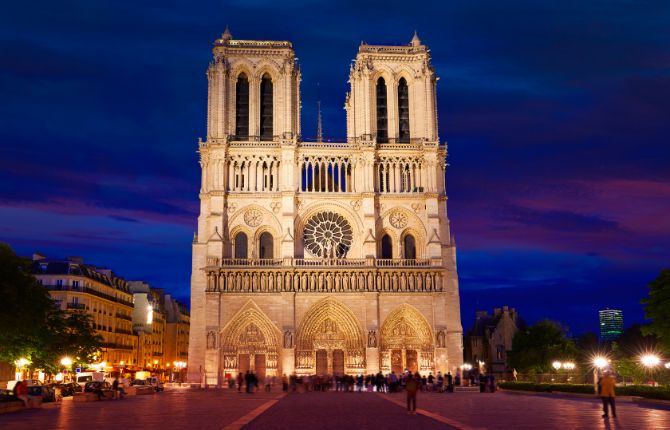
This cathedral has many fascinating features, including flying buttresses that rise fifteen meters above the roof. It was the first building in the world to incorporate these structures, which are now protected by flying buttresses.
The cathedral is an incredible example of medieval architecture, but there is a lot more to see than just the towers.
The Notre Dame Cathedral is an impressive structure in and out of itself. You can enjoy audio tours in several languages.
Visitors can also take advantage of the Paris hop-on-hop-off bus that stops at the cathedral.
While you are in the cathedral, make sure to check out the Cathedral Towers. They provide an outstanding view of the city. However, if you have any physical limitations, you should avoid climbing the towers.
The iconic cathedral is not only the inspiration for the popular novel/movie The Hunchback of Notre-Dame but is also a place for worship and learning. The Cathedral is a UNESCO World Heritage Site and inspired many works of art.
The cathedral’s spires and bell towers were saved by five hundred Parisian firefighters, who were able to save the outer walls of the medieval structure.
3. Gargoyles in Cathédrale Notre-Dame de Paris
The fire that has damaged two-thirds of the roof of Cathedrale Notre-Dame de Paris is under control, according to General Jean-Claude Gallet, commander of the Paris fire department.
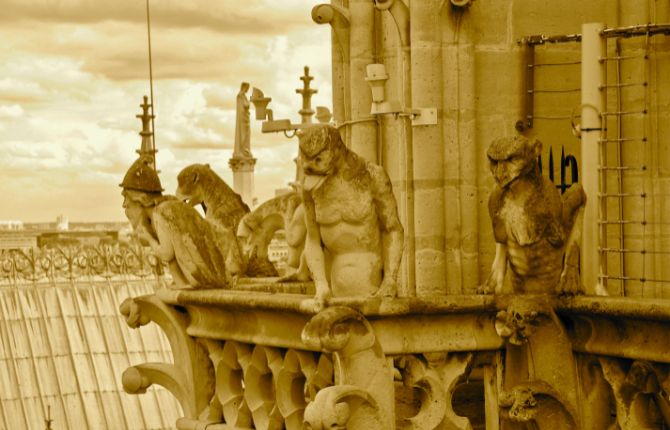
The fire has spared the cathedral’s famous bell towers, religious relics like the crown of thorns, and stunning stained-glass windows, but the fire has caused people to worry about the gargoyles.
The word ‘gargoyle’ has French origins. The French word ‘gargoyle’ literally means “throat,” and these stone carvings are reminiscent of this concept.
In medieval times, the carved creatures were often made in such a way that their mouths opened and outwards to direct rainwater away from the edges of buildings, acting as a sort of drainpipe.
Throughout medieval history, gargoyles were often placed in churches and other Gothic structures, and their presence in Gothic architecture was highly symbolic.
The first gargoyles on Notre Dame were carved in the year 1163. These grotesque-looking creatures were used to direct rainwater away from the foundation of the church.
Early gargoyles were simply channels made from stone and terra cotta. The original gargoyles at Notre Dame were carved dragon-shaped and uniform in shape. The water eventually wore them down and replaced them by 1844.
The restoration of Notre Dame Cathedral was not an easy task, but supporters have found a unique way to raise funds. By adopting statues of the cathedral, people can help support the restoration efforts.
4. Stained-Glass Windows
Located in Paris, France, the Stained-Glass Windows in the Cathedrale Notre-Dame de Paris date back to the 13th century.
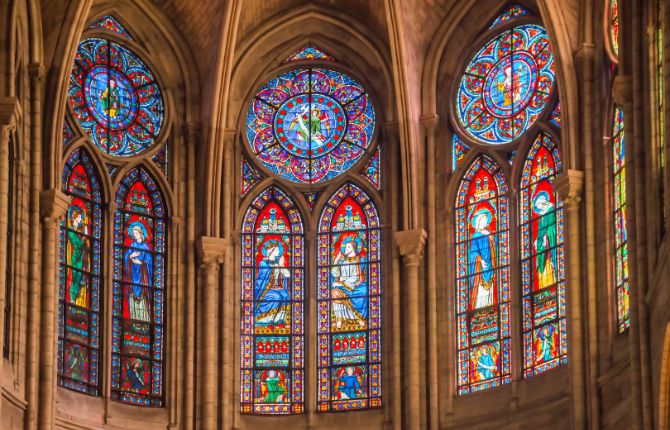
Although the fire on Monday night destroyed much of the cathedral, several pieces of art were saved. The three famed rose windows, which were given by King St. Louis in 1260, were not affected by the fire. However, the condition of the glass is not yet known.
The life of the Saint Eustace window, in particular, contains two distinct colors. These contrasting colors have led Grodecki to conclude that this window was created by an outside artist.
The two other rose windows are located on the north side and the south side. The south rose window depicts Christ the Judge, as well as images of the Wise and Foolish Virgins, the four beasts of Revelation, the twelve apostles, and the twelve apostles.
In addition, two windows depict the figures of Pierre of Dreux, Mauclerc, and Alix of Thouars, as well as their coats of arms.
Despite the great effort and the cost of restoring these windows, some of the damage remains. The blaze itself left traces of damage on the glass. The scientists will now study the glass panels to determine how best to restore the windows.
However, there are concerns that the renovations could damage the glass. Those who are concerned are encouraged to visit the cathedral as soon as possible.
In addition, the restoration work could include bringing modern furnishings into the cathedral.
5. Treasury of Reliquaries
The treasury of the cathedral houses the relics of several saints, including the Holy Crown of Thorns, the crown of David, and the relic of Saint-Denis.
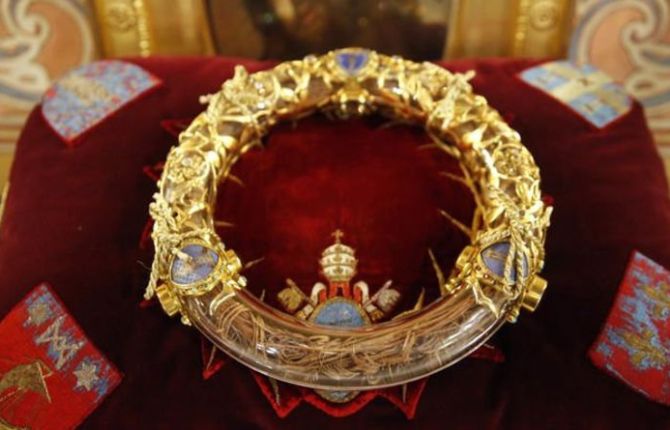
Only three of these relics are on display today, and their absence was revealed after the fire. In the wake of the fire, the French king Louis IX bought them for half the state’s annual budget, thereby creating a cult of the relic and the relics of Saints.
These artifacts were regarded as a way to get closer to God.
The Treasures of the Treasury of Reliquaries in the Cathedrale Notre-Dame de Paris contain a variety of priceless relics. Many are made of gold and display exquisite craftsmanship.
The most precious relic is the gilded bronze and gemstone reliquary, designed by Viollet-le-Duc in 1862 and containing the Holy Crown of Thorns, an object of devotion for more than 1,600 years.
Other Treasures include medieval manuscripts and crosses, and even Napoleon’s coronation robes.
The relics found in the cathedral include the crown of Thorns, a fragment of the cross, and a nail from the Crucifixion. And the relics of Saint-Denis and Saint Genevieve are also kept in the cathedral.
Its three organs, five keyboards, and close to eight thousand pipes make it one of the most musically impressive cathedrals in the world.
6. The Serene Sanctuary
One of the most popular tourist attractions in Paris is the Notre Dame cathedral, which is filled with both tourists and pilgrims.
In spite of the cathedral’s stunning grandeur, the cathedral can be crowded. If you plan to visit this historic cathedral, you should arrive early to enjoy its serenity.
The early birds have the best chance of experiencing the peaceful sanctuary that fills the cathedral.
The spire of the cathedral rises to more than 100 meters above the ground, giving visitors an impressive view of the city. And the Serene Sanctuary is the third floor of the cathedral, which is surrounded by five pillars.
A staircase winds its way through the spire and leads to a balcony of the Virgin. Behind the Virgin, the West rose window creates a halo.
This cathedral is a prime example of Gothic architecture. Saint Louis, who was king during his time, built the church in 1242 CE.
The cathedral has a mural that depicts the Virgin Mary with the infant Jesus. It also features a mural of the Angel Gabriel and Mary Magdalene. The relics of Christ’s Passion can be found in the church’s Gothic chapel.
It also features 15 stained glass windows, although seven of them were damaged during the French Revolution.
The Transept, located in the southwest corner of the cathedral, is also worth a visit. It was created during the 19th century and depicts the life of Saint Genevieve, the patron saint of Paris. It is home to several Gothic statues.
There are also many modern stained-glass windows that depict religious stories. This cathedral has an impressive number of statues and chapels and is an exceptional tourist destination.
Cathédrale Notre-Dame de Paris
- Gothic Architecture in Cathédrale Notre-Dame de Paris
- Cathedral Towers in Cathédrale Notre-Dame de Paris
- Gargoyles in Cathédrale Notre-Dame de Paris
- Stained-Glass Windows
- Treasury of Reliquaries
- The Serene Sanctuary


